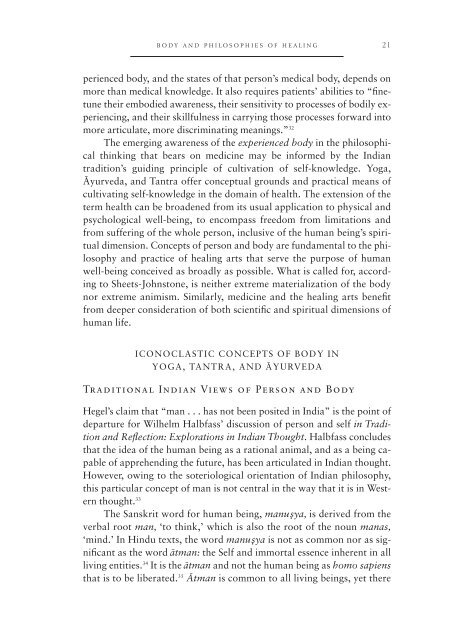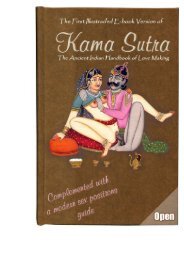body and health in yoga, Ayurveda, and Tantra
body and health in yoga, Ayurveda, and Tantra
body and health in yoga, Ayurveda, and Tantra
You also want an ePaper? Increase the reach of your titles
YUMPU automatically turns print PDFs into web optimized ePapers that Google loves.
ody <strong>and</strong> philosophies of heal<strong>in</strong>g 21<br />
perienced <strong>body</strong>, <strong>and</strong> the states of that person’s medical <strong>body</strong>, depends on<br />
more than medical knowledge. It also requires patients’ abilities to “f<strong>in</strong>etune<br />
their embodied awareness, their sensitivity to processes of bodily experienc<strong>in</strong>g,<br />
<strong>and</strong> their skillfulness <strong>in</strong> carry<strong>in</strong>g those processes forward <strong>in</strong>to<br />
more articulate, more discrim<strong>in</strong>at<strong>in</strong>g mean<strong>in</strong>gs.” 32<br />
The emerg<strong>in</strong>g awareness of the experienced <strong>body</strong> <strong>in</strong> the philosophical<br />
th<strong>in</strong>k<strong>in</strong>g that bears on medic<strong>in</strong>e may be <strong>in</strong>formed by the Indian<br />
tradition’s guid<strong>in</strong>g pr<strong>in</strong>ciple of cultivation of self-knowledge. Yoga,<br />
Åyurveda, <strong>and</strong> <strong>Tantra</strong> offer conceptual grounds <strong>and</strong> practical means of<br />
cultivat<strong>in</strong>g self-knowledge <strong>in</strong> the doma<strong>in</strong> of <strong>health</strong>. The extension of the<br />
term <strong>health</strong> can be broadened from its usual application to physical <strong>and</strong><br />
psychological well-be<strong>in</strong>g, to encompass freedom from limitations <strong>and</strong><br />
from suffer<strong>in</strong>g of the whole person, <strong>in</strong>clusive of the human be<strong>in</strong>g’s spiritual<br />
dimension. Concepts of person <strong>and</strong> <strong>body</strong> are fundamental to the philosophy<br />
<strong>and</strong> practice of heal<strong>in</strong>g arts that serve the purpose of human<br />
well-be<strong>in</strong>g conceived as broadly as possible. What is called for, accord<strong>in</strong>g<br />
to Sheets-Johnstone, is neither extreme materialization of the <strong>body</strong><br />
nor extreme animism. Similarly, medic<strong>in</strong>e <strong>and</strong> the heal<strong>in</strong>g arts benefit<br />
from deeper consideration of both scientific <strong>and</strong> spiritual dimensions of<br />
human life.<br />
ICONOCLASTIC CONCEPTS OF BODY IN<br />
YOGA, TANTRA, AND ÅYURVEDA<br />
Traditional Indian Views of Person <strong>and</strong> Body<br />
Hegel’s claim that “man . . . has not been posited <strong>in</strong> India” is the po<strong>in</strong>t of<br />
departure for Wilhelm Halbfass’ discussion of person <strong>and</strong> self <strong>in</strong> Tradition<br />
<strong>and</strong> Reflection: Explorations <strong>in</strong> Indian Thought. Halbfass concludes<br />
that the idea of the human be<strong>in</strong>g as a rational animal, <strong>and</strong> as a be<strong>in</strong>g capable<br />
of apprehend<strong>in</strong>g the future, has been articulated <strong>in</strong> Indian thought.<br />
However, ow<strong>in</strong>g to the soteriological orientation of Indian philosophy,<br />
this particular concept of man is not central <strong>in</strong> the way that it is <strong>in</strong> Western<br />
thought. 33<br />
The Sanskrit word for human be<strong>in</strong>g, manuÓsya, is derived from the<br />
verbal root man, ‘to th<strong>in</strong>k,’ which is also the root of the noun manas,<br />
‘m<strong>in</strong>d.’ In H<strong>in</strong>du texts, the word manuÓsya is not as common nor as significant<br />
as the word ātman: the Self <strong>and</strong> immortal essence <strong>in</strong>herent <strong>in</strong> all<br />
liv<strong>in</strong>g entities. 34 It is the ātman <strong>and</strong> not the human be<strong>in</strong>g as homo sapiens<br />
that is to be liberated. 35 Åtman is common to all liv<strong>in</strong>g be<strong>in</strong>gs, yet there



